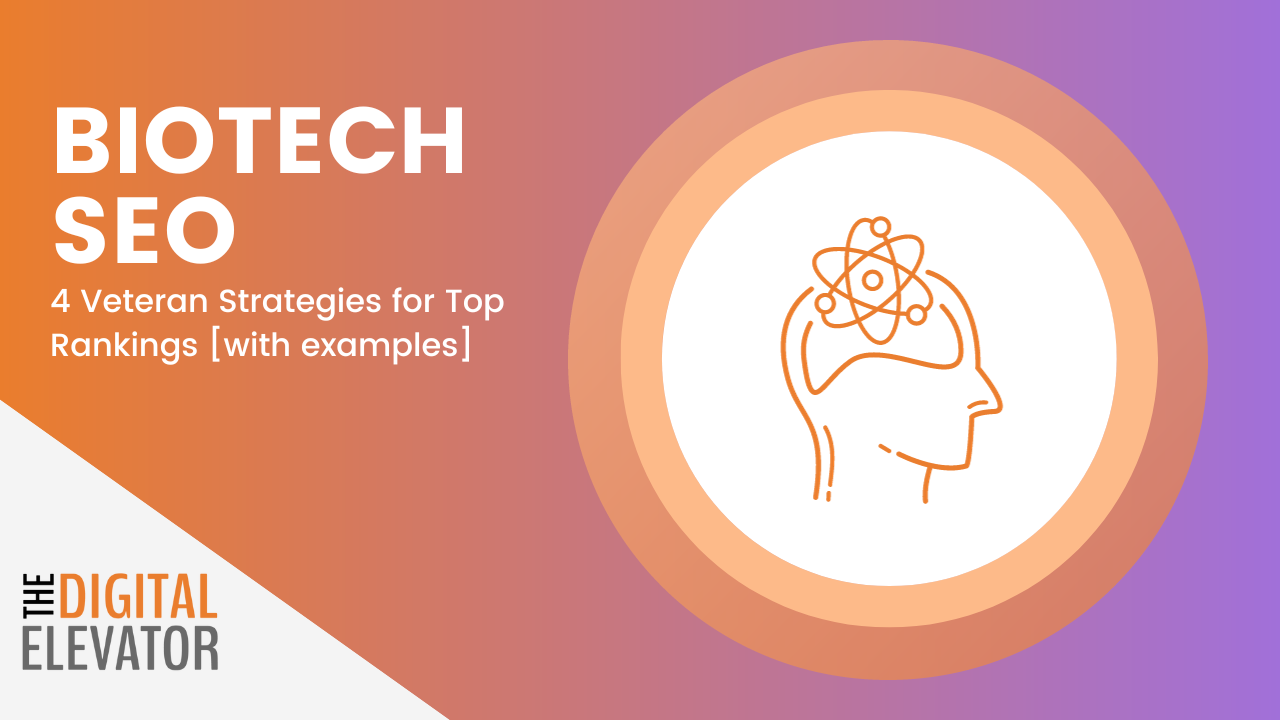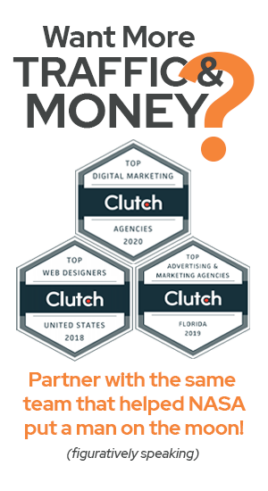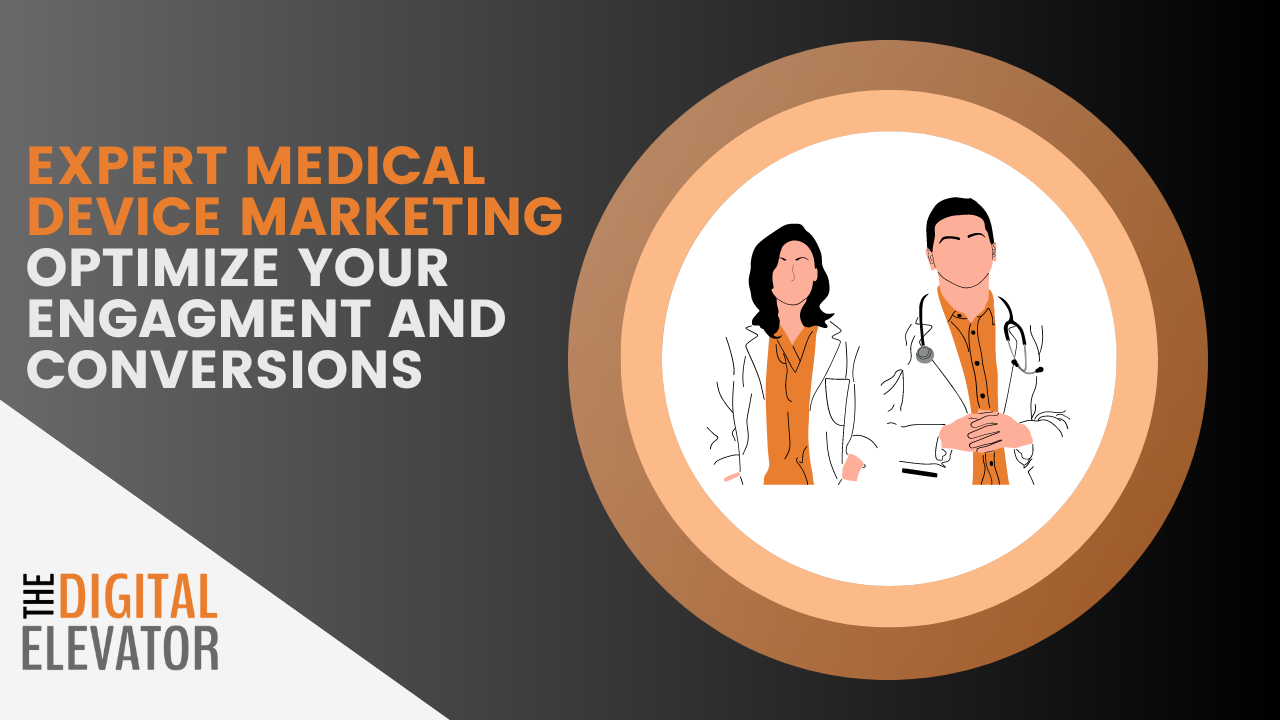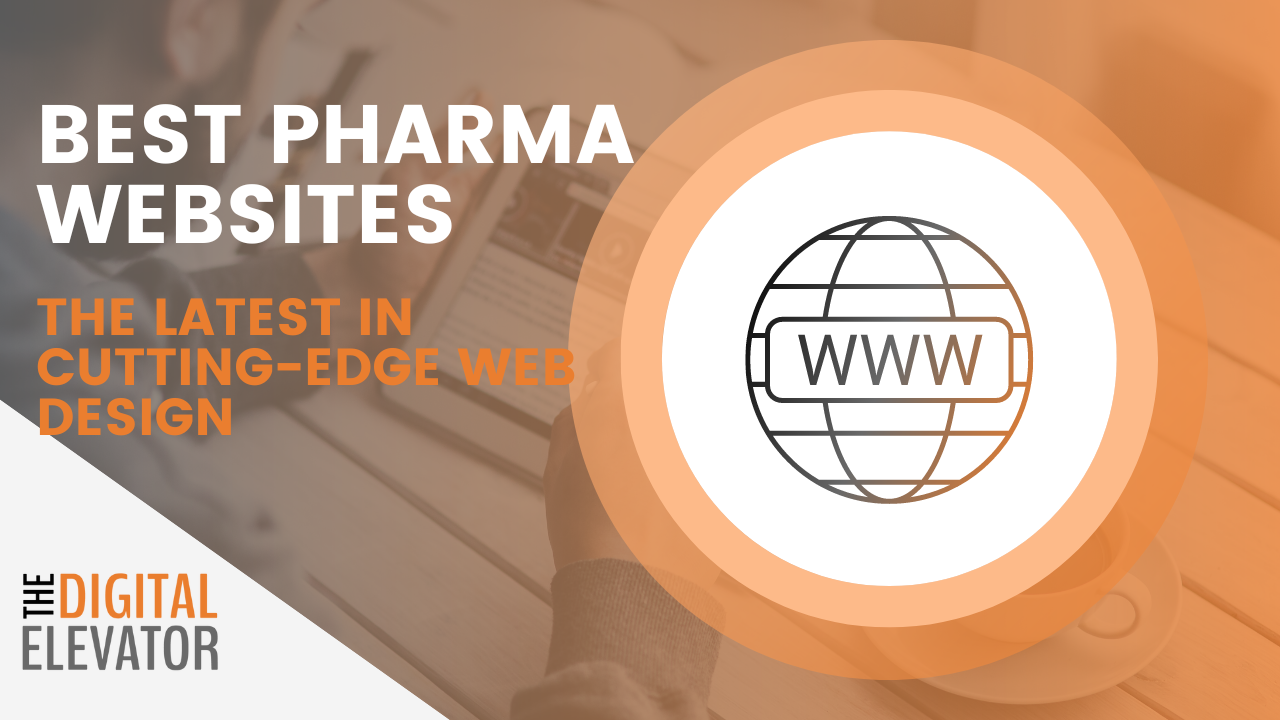If you are trying to rank your biotech website and earn free search engine traffic, the focus areas of your SEO campaign can admittedly be difficult to triage.
This guide will outline an SEO strategy tailored for biotech companies, encompassing key aspects such as competitor analysis, on-page optimization, SEO-driven content marketing, and off-page SEO techniques.
These are many of the strategies we use at our biotech SEO agency to help rank sites in competitive verticals that need to capitalize on gaining market share.
Competitor Analysis: Understanding the Landscape
Before embarking on any SEO campaign, it is important to conduct a thorough SEO competitor analysis to gain insights into the strategies employed by your rivals. This involves identifying your top competitors’ rankings, analyzing their website structure and content, and evaluating their backlink profiles.
By understanding their strengths and weaknesses as they concern rankings and traffic generation, you can identify gaps in their approach and develop a plan to differentiate your biotech company's online presence. It also provides data on how competitive your vertical is and prepares your team strategically for the areas it needs to spend more time in.
For example, check out the below example of a search engine results page (SERP) pulled from SEO software Ahrefs. The top five sites for the search "cloud lab as a service" provide us with a few important qualitative and quantitative metrics that give an understanding of the competition:
- The Search result reveals whether blogs, products pages, or some other resource takes the top spots. In this case, the top two spots are taken by a FAQ or glossary-type resource, while the other results are for products. If I wanted to rank for this keyword, I'd probably create a similar resource as the top two spots as that is what Google is showing as the preferred intent behind this search.
- The DR and Domains columns indicate the domain rating and the amount of referring domains the URL has, respectively. The higher the DR, the more difficult it might be to rank for the keyword. In this case, the highest DR on this search is a DR57. The referring domains range from 0 to 97, but the 97 referring domains are for the result that showcases a homepage, so that naturally would have more links. All things considered, if I had a site that wanted to compete for this keyword I'd need to weight all these factors into my SEO gameplan.

At Digital Elevator, we run competitive analysis to provide data-driven insights on factors such as:
- Who your actually Google organic competitors really are
- What keywords they are targeting via keyword gap analysis
- Why they are successful with their content marketing strategy
- The link building metrics that make them successful
- The conversion rate optimization strategies that they are using
- What digital marketing strategies they are using effectively
- Where they fall short and where you can strategically position yourself to win
As seen in the example above, a lot of SEO is reverse-engineering what works well with competitors and then creating better content or implementing better SEO strategies to overtake them. This step is the equivalent of a football coach having his team watch a competitor's video to understand exactly what their competition is doing well, where they fall short, and determining where his team can win.
On-Page SEO is the Foundational Work Driven by Keyword Research
On-page SEO refers to the optimization of your website's content and structure. This includes things like the implementation of keyword research, title tags, meta descriptions, site speed and internal linking.
Each of these sub-topics deserves guides of their own, so rather than trying to drill down into each area, I’ll provide my most actionable recommendations.
Keyword research
At the end of the day, people are still typing words into search engines and looking for applicable results. The key terms there being “applicable,” or contextually relevant results.
Google ultimately decides what the intent is of each search so any good keyword research involves an understanding of the intent of a search as well as:
- Keyword volume
- Keyword difficulty
When selecting the keywords you want to target for your biotech, it is important to implement them according to the appropriate sections of your site. For example:
Transactional intent keywords
These are for users who want to buy something now. I’d recommend these for your product or service pages specifically.
For example, a search for “research lab management software” is highly transactional in intent, and is representative of a searcher looking to buy software. As shown in the example below, this is an opportunity to target a service page (or in this example, the homepage) of your site to the search.
On the other hand, another intent might be centered around seeking information.
Informational intent keywords
For example, a how to search like the below is more informational and is better-suited as a blog or resource rather than a service page.
When creating a new SEO campaign, we always prioritize the “money-making pages” over the informational-type pages. Commercial intent keywords, and therefore pages, are considered bottom of the funnel and where you want to focus your keyword research and content efforts before trying to drive more traffic with informational intent searches.
While a user might land on your site from an informational search, it’s the money-making product or service pages that convert them into customers.
Other areas to focus on for on-page SEO include:
1. Title Tags and Meta Descriptions:
Title tags and meta descriptions are the snippets of text that appear in the search engine results pages (SERPs). They are an important factor in determining whether or not people will click on your website.
Title tags should be no more than 60 characters long and should include your target keyword. Meta descriptions should be no more than 160 characters long and should provide a brief overview of your website's content.
Ahrefs has a cool title tag and meta description generators you can use to get results like this:
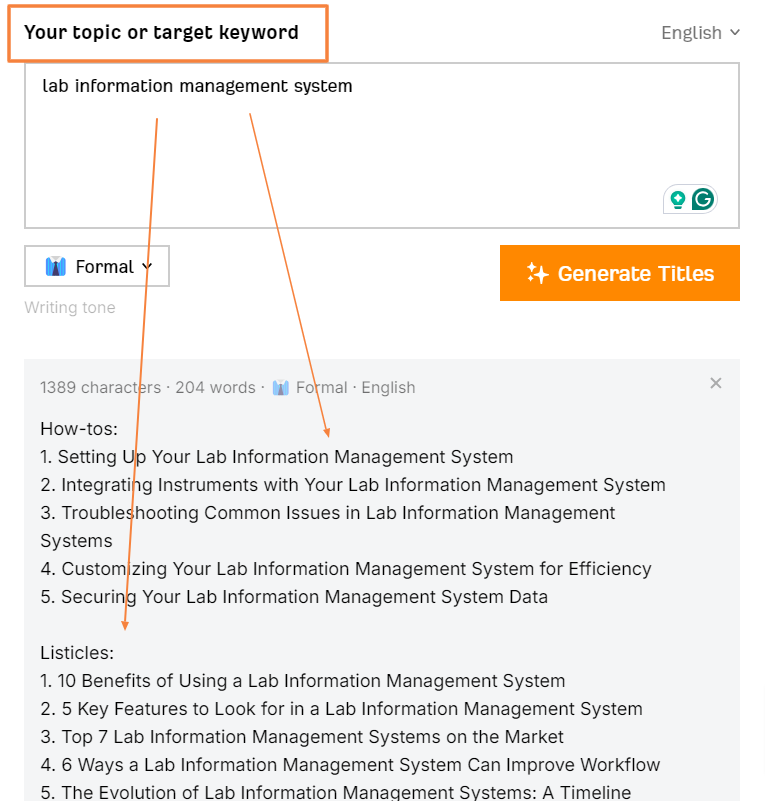
2. Header Tags:
Header tags are used to structure your website's content and to indicate the hierarchy of information on each page. Search engines use header tags to understand the main points of your website's content and to rank your website for relevant keywords.
Use h1 tags for the main title of your page, h2 tags for subheadings, and h3 tags for sub-subheadings, infusing relevant keywords into each to try to rank for as many keywords as possible. For example, here are some the h1 and subheadings for this post:
H1: Biotech SEO: 4 Veteran Strategies for Top Rankings [with examples]
H3: Competitor Analysis: Understanding the Landscape
H2: On-Page SEO is the Foundational Work Driven by Keyword Research
H2: SEO-driven Content Marketing: Conversion-focused Traffic Generation
H2: Off-page SEO: Off Site Signals That Boost Rankings
H2: Should I Go In-house or Use an Agency for SEO?
3. Image Alt Text:
Image alt text is the text that appears in place of an image if it cannot be displayed for some reason. It is also used by search engines to index your images and to understand the content of your website.
Image alt text should be descriptive and should include your target keyword. To save time, check out this AI image alt text generator.
4. Website Speed:
Website speed is a critical factor in SEO. If your website takes too long to load, people will abandon it and you will lose traffic. It is also a ranking signal.
There are a number of things you can do to improve your website speed, such as optimizing your images, using a content delivery network (CDN), and minifying your code. Use a tool like GTmetrix to analyze pagespeed and get actionable insights.
Sitespeed improvement, in general, is usually a task best suited for development teams in conjunction with server, or hosting experts.
5. User Experience:
User experience (UX) is another important factor in SEO. If your website is difficult to use, people will not want to spend time on it.
Make sure your website is easy to navigate and that your content is easily readable. You should also make sure that your website is mobile-friendly, as more and more people are accessing the internet from their smartphones and tablets.
For example, the below homepage is an example of poor UX. It is not immediately clear what action a user should take when they land on the page, what buttons to press, what menu options to click, or how the site can help me. This design, in all likelihood, would result in decreased leads.
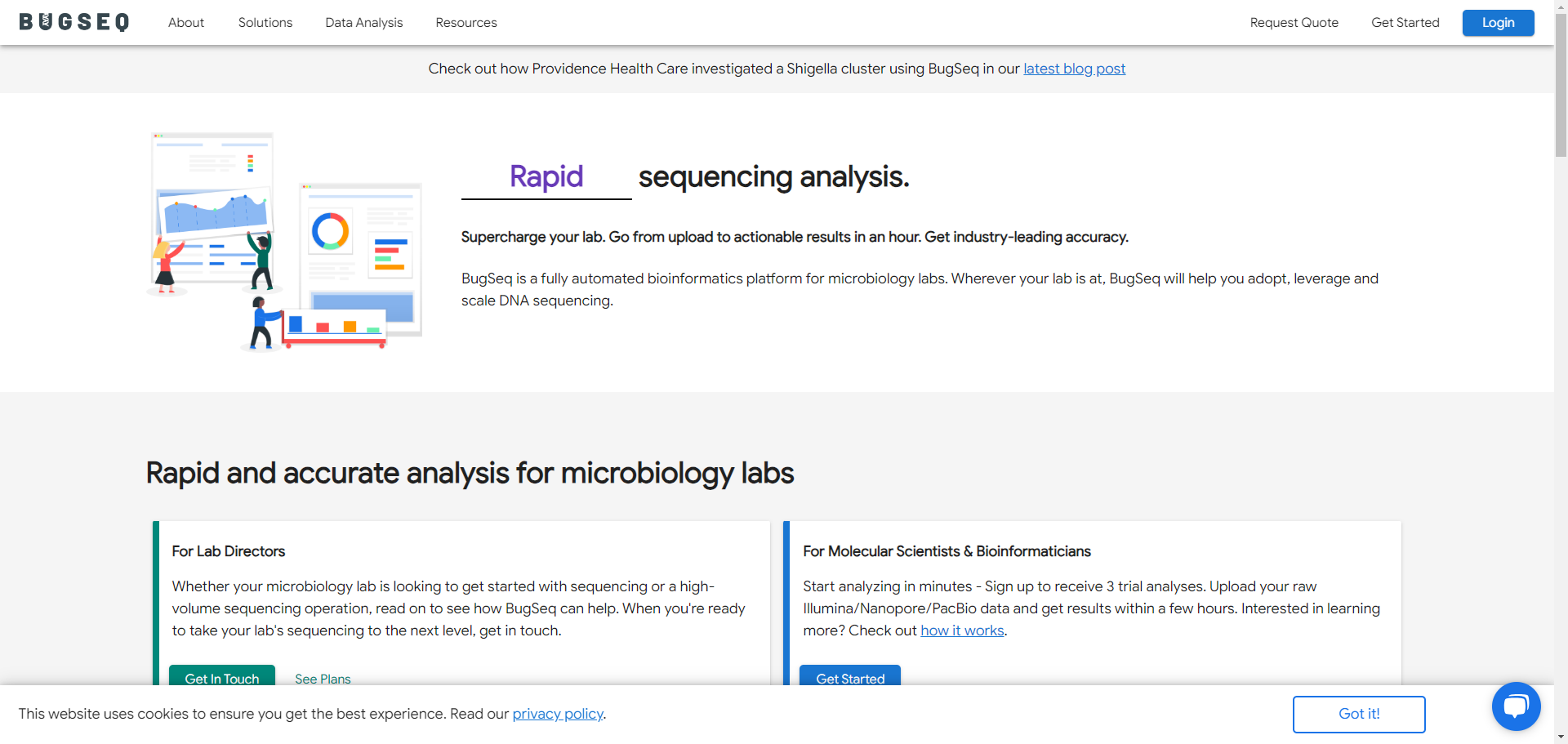
SEO-driven Content Marketing: Conversion-focused Traffic Generation
Above, we touched on the types of topics to cover for your transactional, or product and services pages. Beyond those foundational SEO pages, a major source of traffic can come from SEO-driven content marketing.
Content marketing is the process of creating and sharing valuable, relevant, and consistent content to attract and engage a clearly defined audience — and, ultimately, to drive profitable customer action.
Related: Biotech Content Marketing Strategy
In the biotechnology industry, content marketing can be a powerful way to attract new customers, educate your target audience, and establish your company as a thought leader. There are a number of different types of content that you can create for your content marketing strategy, such as blog posts, infographics, case studies, and white papers.
At Digital Elevator, we focus on what is called SEO-driven content marketing. This means that the content we create is versed in SEO and is driven by search volume and intent as much as it is driven by providing exceptional content to our clients’ readers.
Here are some of our favorite examples:
Roundup posts
This Research.com roundup post ranks for over 300 keywords related to "clinical trial software," "clinical trial management software," and "clinical trial management systems." Roundup posts- articles where you do side-by-side comparisons of competitors, software, or products – can often be bottom of the funnel content types where users will visit them to make final decisions.
Resource Hubs or Blogs?
Resource hub or blogs? Which strategy is most effective?
They both fall under the strategy of content marketing.
They both often provide a wealth of topic ideas.
However, many biotechs get this wrong from the start and create content that sort of blends both instead of keeping them isolated from a navigational standpoint and a content layout standpoint.
Resource content is generally to the point, fluff-free, and data-driven (objective). Blog content is often more conversational, offering perspectives and potential opinions (subjective).
When possible, it's best to incorporate both, as both strategies can identify high volume and often high intent keyword opportunities.
For example, Excedr, a life science lab equipment lessor, capitalizes on both:
Blog
- 30k organic visits/month
- PPC equivalent value of $19k/mo
- ranks for 30k keywords
- 300+ pages published
Resource hub
- 22k organic visits/month
- PPC equivalent value of $18k/mo
- ranks for 21k keywords
- 200+ pages published
Resource
Here's a great example of a biotech content marketing resource from Thermo Fisher Scientific.
I'll get to why, but first some SEO metrics:
- it drives an estimated 7,600 organic visits per month
- the equivalent PPC traffic would cost $5,500 per month
- it ranks for 1,500 keywords
- it has earned 41 referring domains
This content resource on Useful Numbers for Cell Culture is a great example of SEO-driven content marketing for so many reasons:
1. It's useful to their target audience
Lab techs or scientists who need to order cell culture dishes/flasks would find this grid layout really simple and informative.
2. It's related to product offerings
Should the lab techs need these products, the simplicity of understanding exactly what they need accompanied by links to the products makes this resource a real winner.
3. It's probably a highly lucrative page in terms of content marketing investment
ThermoFisher probably knew the potential search volume from this page. Researching, planning, developing, and then ranking this page probably took quite a bit of work. However, if we look at some average conversion rates, you can see how lucrative something like this can be for an eComm biotech:
8,000 visits per month
x 2% conversion rate (modest average)
~$400 per order
= $64,000 in revenue per month
When creating content for your content marketing strategy, it is important to keep your target audience in mind. What are their interests and needs? What kind of information are they looking for? Once you understand your target audience, you can create content that is relevant and engaging.
Off-page SEO: Off-Site Signals That Boost Rankings
Off-page SEO refers to all the activities that you do outside of your website to improve its ranking in search engine results pages (SERPs). These activities can be divided into two broad categories:
Link building: This involves getting other websites to link to your website. The more high-quality links your website has, the higher its authority will be in the eyes of search engines.
Brand mentions: These are mentions of your brand or website on other websites. The more brand mentions a website has, the more relevant and trustworthy it will appear to search engines.
Modern day SEO recommends the organic, as opposed to forced, building of links and brand mentions. The best way to do this is via digital public relations (PR).
For biotechs that are trying to get in front of partners, investors, or pharmaceutical executives, getting exposure in major media outlets is good for business and for SEO. When you get featured on media outlets, they will often mention your brand or link to your website, both of which are search engine signals that can help to rank your website.
For new brands this is often an ideal starting point for off-page SEO as it builds trust signals with search engines that will help reinforce additional SEO efforts.
Ranking individual pages for target keywords involves a bit of a different link building strategy, and that is where many life science companies leverage Biotech SEO agencies. Where digital PR often generates brand mentions or links to the homepage, ranking individual URLs is an entirely different endeavor.
To rank individual pages, you first need to get a baseline of:
- Your primary keyword target
- The potential search traffic of ranking the page
- How competitive the target keyword for that page is (indicated by SEO software)
- The amount of referring domains your competitors have to pages targeting the same keyword
From there, SEO will come up with a baseline number of the amount of links needed to rank a page. To get these links, we can employ a number of different link building techniques. Check out this resource on link building strategies to learn more.
Should I Go In-house or Use an Agency for SEO?
The decision of whether to handle your SEO in-house or hire an agency is a complex one. There are a number of factors to consider, such as your budget, your in-house expertise, and your desired level of control.
If you have a large budget and a team of experienced SEO professionals, you may be able to handle your SEO in-house. However, if you have a limited budget or in-house expertise, you may want to consider hiring an agency.
A biotech SEO agency can provide you with several benefits, such as access to expert SEO professionals, access to specialized tools and resources, and a proven track record of success.
There are additional considerations for SEO and launching campaigns as well.
There can be an opportunity cost in not working with a marketing agency.
The time it takes to get something to market matters.
If a marketing agency can take something to market in half the time it takes an in-house team, consider the impact that can have on your business.
Those potentially untapped leads will be further along your sales cycle, and the ROI from investing in marketing with an agency will have a significant business impact compared to trying to save money using an in-house team that has a different focus.
As you plan ahead or are getting SEO budgets together, consider the opportunity cost of not launching marketing campaigns quickly and effectively.
